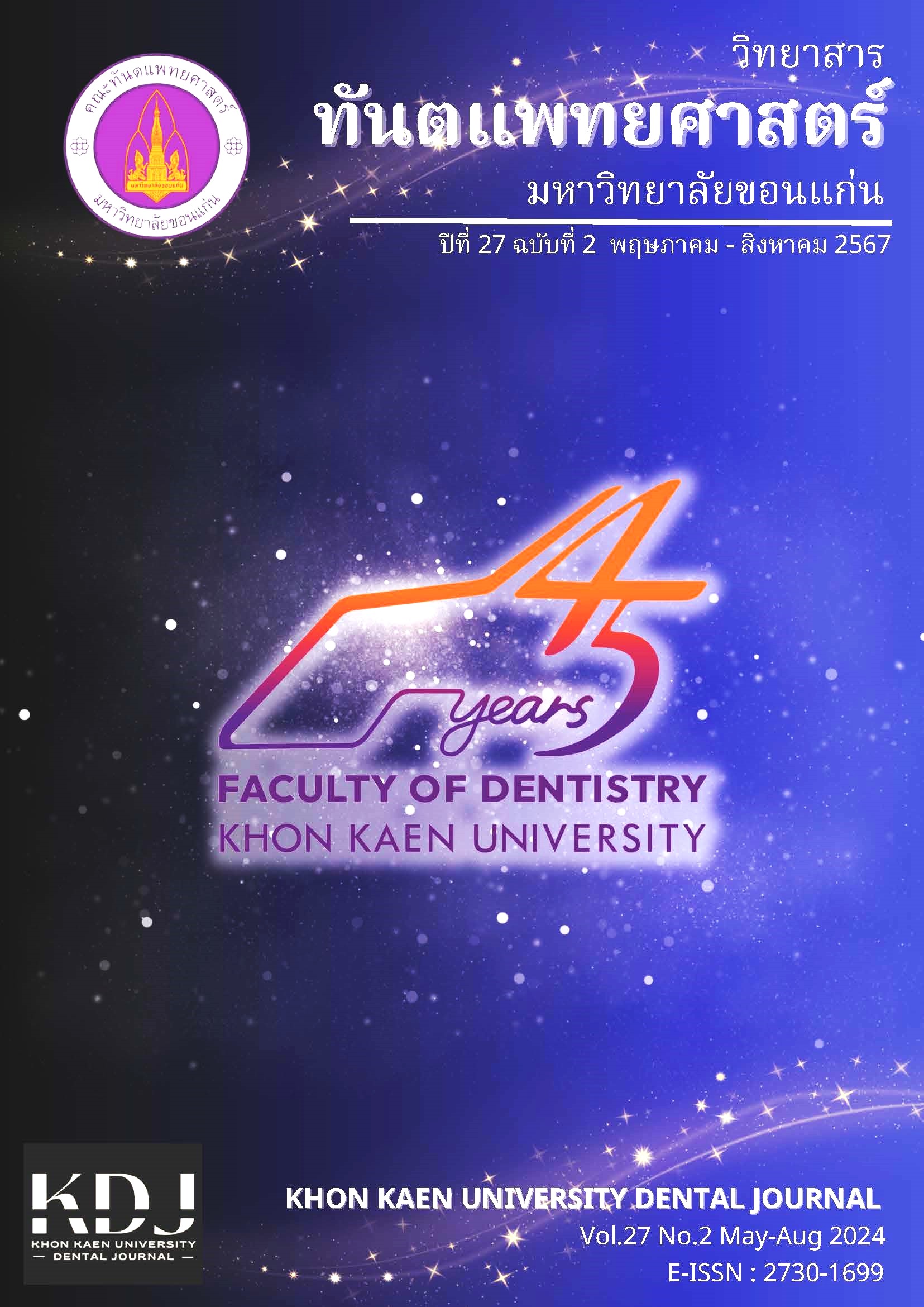Anti-Palatal Fibroblast Cells Migration of 5-Aminolevulinic Acid Photodynamic Therapy; in vitro
Main Article Content
Abstract
Palatoplasty on a patient with a cleft palate resulted in the creation of palatal scars. Photodynamic therapy (PDT) is used as an alternative treatment for scar reduction. 5-Aminolevulinic acid (5-ALA) PDT was reported to have the ability of anti-fibrotic in human vocal fold fibroblasts. This study aimed to investigate the anti-migration effect of 5-ALA PDT on palatal fibroblast cells. Palatal fibroblast cells were treated with various concentrations of 5-ALA PDT and evaluated to determine the role of 5-ALA PDT on migration ability. Cell migration was conducted and analyzed by scratch wound healing and collagen contraction assay. The results of the study found that the percentage of cell viability diminished steadily as the concentration increased, and sub-lethal concentration was 0.01, 0.05, 0.1, and 0.2 mM, with 635 nm red light emitting diode (LED), 50 mW/cm2, 10 J/cm2. The migration of human palate fibroblast cells was inhibited by 5-ALA at doses of 0.1 and 0.2 mM. However, in this study 0.2 mM 5-ALA PDT caused abnormal morphology of cells. In conclusion, the optimal condition 5-ALA PDT for suppressing palatal fibroblast migration without causing cell damage was 0.1 mM 5-ALA PDT with 635-nm red LED at 50 mW/cm2, 10J/cm2.
Article Details

This work is licensed under a Creative Commons Attribution-NonCommercial-NoDerivatives 4.0 International License.
บทความ ข้อมูล เนื้อหา รูปภาพ ฯลฯ ที่ได้รับการลงตีพิมพ์ในวิทยาสารทันตแพทยศาสตร์ มหาวิทยาลัยขอนแก่นถือเป็นลิขสิทธิ์เฉพาะของคณะทันตแพทยศาสตร์ มหาวิทยาลัยขอนแก่น หากบุคคลหรือหน่วยงานใดต้องการนำทั้งหมดหรือส่วนหนึ่งส่วนใดไปเผยแพร่ต่อหรือเพื่อกระทำการใด ๆ จะต้องได้รับอนุญาตเป็นลายลักษณ์อักษร จากคณะทันตแพทยศาสตร์ มหาวิทยาลัยขอนแก่นก่อนเท่านั้น
References
Proffit WR, Fields HW, Larson BE, Sarver DM. Contemporary orthodontics. 6th ed. Philadephia: Elsevier; 2019.
Ross RB. Growth of the facial skeleton following the Malek repair for unilateral cleft lip and palate. Cleft Palate Craniofac J 325 1995;32(3):194-8.
J Liu, EN Lamme, RPM Steegers, IPC Krapels, Z Bian, H Marres et al. Cleft palate cells can regenerate a palatal mucosa in vitro. J Dent Res 2008;87(8):788-92.
Morton C, Szeimies RM, Sidoroff A, Wennberg AM, Basset-Seguin N, Calzavara-Pinton P, et al. European dermatology forum guidelines on topical photodynamic therapy. Eur J Dermatol 2015;25(4):296-311.
Bruscino N, Lotti T, Rossi R. Photodynamic therapy for a hypertrophic scarring: a promising choice. Photodermatol Photoimmunol Photomed 2011;27(6):334-5.
Campbell SM, Tyrrell J, Marshall R, Curnow A. Effect of MAL-photodynamic therapy on hypertrophic scarring. Photodiagnosis Photodyn Ther 2010 Sep;7(3):183-8.
Dolmans DE, Fukumura D, Jain RK. Photodynamic therapy for cancer. Nat Rev Cancer 2003;3(5):380-7.
Biel MA. Photodynamic therapy treatment of early oral and laryngeal cancers. Photochem Photobiol 2007;83(5): 1063-8.
Zhang C, Wang J, Chou A, Gong T, Devine EE, Jiang JJ. Photodynamic therapy induces antifibrotic alterations in primary human vocal fold fibroblasts. Laryngoscope 2018;128(9):E323-31.
Morton CA, Szeimies RM, Basset-SéguinN, Calzavara-Pinton PG, Gilaberte Y, et al. European Dermatology Forum guidelines on topical photodynamic therapy 2019 Part 2: emerging indications–field cancerization, photorejuvenation and inflammatory/infective dermatoses. J Eur Acad Dermatol Venereol 2020;34:17-29.
Wachowska M, Muchowicz A, Firczuk M, Gabrysiak M, Winiarska M, Wańczyk M, et al. Aminolevulinic Acid (ALA) as a prodrug in photodynamic therapy of cancer. Molecules 2011;16(5):4140-64.
Tosa M, Ogawa R. Photodynamic therapy for keloids and hypertrophic scars: a review. Scars Burn Heal 2020; 6:2059513120932059.
Karrer S, Bosserhoff AK, Weiderer P, Landthaler M, Szeimies RM. Influence of 5-aminolevulinic acid and red light on collagen metabolism of human dermal fibroblasts. J Invest Dermatol 2003;120(2):325-31.
Gomes A, Fernandes E, Lima JL. Fluorescence probes used for detection of reactive oxygen species. J Biochem Biophys Methods 348 2005;65(2-3):45-80.
Cao Y, Koo YE, Koo SM, Kopelman R. Ratiometric singlet oxygen nano-optodes and their use for monitoring photodynamic therapy nanoplatforms. Photochem Photobiol 2005;81(6):1489-98.
Jang YH, Koo GB, Kim JY, Kim YS, Kim YC. Prolonged activation of ERK contributes to the photorejuvenation effect in photodynamic therapy in human dermal fibroblasts. J Invest Dermatol 2013;133(9):2265-75.
Bell E, Ivarsson B, and Merrill C. Production of a tissue-like structure by contraction of collagen lattices by human fibroblasts of different proliferative potential in vitro. Proc Natl Acad Sci U S A 1979;76(3):1274-78.
Yang TH, Chen CT, Wang CP, Lou PJ. Photodynamic therapy suppresses the migration and invasion of head and neck cancer cells in vitro. Oral oncol 2007;43(4):358-65
Desmoulière A, Chaponnier C, Gabbiani G. Tissue repair, contraction, and the myofibroblast. Wound Repair Regen 2005;13(1):7-12.
Grinnell F, Fibroblasts, myofibroblasts, and wound contraction. J Cell Biol 1994;124(4):401-04.
Bodo M, Baroni T, Carinci E, Becchetti E, Bellucci C, Pezzetti F, et al. TGFβ isoforms and Decorin gene expression are modified in fibroblasts obtained from non-syndromic cleft lip and palate subjects. J Dent Res 1999;78(12):1783-90.
Bosi G, Evangelisti R, Valeno V, Carinci F, Pezzetti F, Calastrini C, et al. Diphenylhydantoin affects glycosaminoglycans and collagen production by human fibroblasts from cleft palate patients. J Dent Res 1998;77(8):1613-21.


